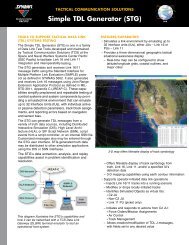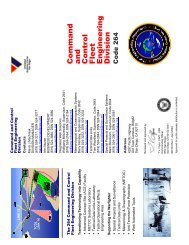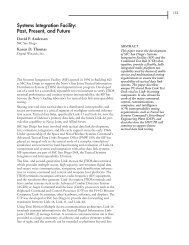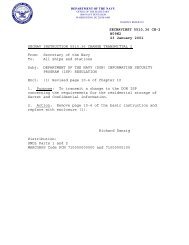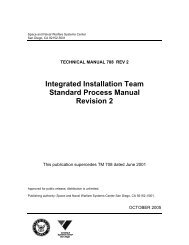Intelligence, Surveillance, and Reconnaissance - Spawar
Intelligence, Surveillance, and Reconnaissance - Spawar
Intelligence, Surveillance, and Reconnaissance - Spawar
Create successful ePaper yourself
Turn your PDF publications into a flip-book with our unique Google optimized e-Paper software.
182<br />
INTELLIGENCE, SURVEILLANCE, AND RECONNAISSANCE<br />
DADS TECHNOLOGY<br />
DADS consists of three major components: sensor nodes, communication<br />
gateways, <strong>and</strong> a control terminal. Sensor nodes consist of a 100meter<br />
array containing 28 hydrophones <strong>and</strong> 3 magnetometers, a communication<br />
module consisting of an<br />
undersea acoustic modem <strong>and</strong><br />
transducer, <strong>and</strong> an electronics<br />
module containing processing<br />
electronics <strong>and</strong> battery. Figure 2<br />
is a drawing of the DADS sensor<br />
node components.<br />
Communication gateways can<br />
either be moored buoys or mobile<br />
autonomous undersea vehicles.<br />
Both moored <strong>and</strong> mobile gateways<br />
contain acoustic <strong>and</strong> RF<br />
modems <strong>and</strong> associated transducers<br />
<strong>and</strong> antennas. DADS sensors<br />
<strong>and</strong> gateways, as deployed in the<br />
ocean, are shown in Figure 3.<br />
The control terminal is located in<br />
the ASW Control Center <strong>and</strong><br />
consists of a laptop computer <strong>and</strong><br />
RF communications electronics.<br />
The computer provides control of<br />
the sensor nodes <strong>and</strong> gateways<br />
<strong>and</strong> also displays the current<br />
status of the system <strong>and</strong> contact<br />
report information. An important<br />
element of the DADS is automated<br />
target recognition <strong>and</strong> contact<br />
reporting. The objective is to distinguish<br />
submarines from surface<br />
ships <strong>and</strong> report their presence [2].<br />
BATTERY AND<br />
PROCESOR<br />
MODULE<br />
FIGURE 2. DADS sensor-node components.<br />
To provide a robust detection,<br />
classification, <strong>and</strong> localization<br />
capability in the littoral, a combination of acoustic <strong>and</strong> electromagnetic<br />
sensors <strong>and</strong> associated signal-processing algorithms are used. Major signalprocessing<br />
components in the sensor node include detection, tracking,<br />
track association, feature extraction, contact classification, <strong>and</strong> contact<br />
reporting [3].<br />
To meet system-lifetime objectives, it is important to minimize the flow<br />
of contact report data among sensor nodes in the DADS network.<br />
Therefore, it is desirable to do as much contact classification in the sensor<br />
node as possible. In the DADS concept, the initial classification processing<br />
in the sensor node uses two sources of information to distinguish a<br />
contact of interest from all other contacts:<br />
1. Magnetic Matched-Field Tracking (MMFT) Features—The MMFT<br />
process uses magnetometer data to generate a three-dimensional<br />
track for the contact. This track, therefore, defines the contact<br />
depth, along with the track dynamics. The MMFT process also<br />
estimates the contact’s magnetic moment. These features are used as<br />
A)<br />
C)<br />
0.91 METERS<br />
ACOUSTIC COMMUNICATONS<br />
TRANSDUCER<br />
AND FLOAT<br />
ACOUSTIC AND ELECTROMAGNETIC SENSOR ARRAY<br />
100 METERS<br />
FIGURE 3. DADS (A) acoustic modem, (B) moored <strong>and</strong> mobile gateways, (C) magnetometer,<br />
<strong>and</strong> (D) hydrophone.<br />
B)<br />
D)



